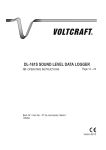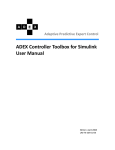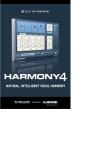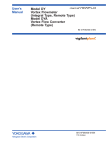Download RobinAir TruTrack Ultrasonic Leak Detector 16455 User's Manual
Transcript
Operating Manual Model 16455 TruTrack Ultrasonic Leak Detector Table of Contents Introduction . . . . . . . . . . . . . . . . . . . . . . . . . . . . 2 Description . . . . . . . . . . . . . . . . . . . . . . . . . . . 2 Theory of Operation . . . . . . . . . . . . . . . . . . . . . . . . 3 Operation of Unit . . . . . . . . . . . . . . . . . . . . . . . . . 4 Tips on Use . . . . . . . . . . . . . . . . . . . . . . . . . . . . 5 A Note About Sensitivity . . . . . . . . . . . . . . . . . . . . . . 6 The Contact Probe . . . . . . . . . . . . . . . . . . . . . . . . 6 Background Noise . . . . . . . . . . . . . . . . . . . . . . . . . 7 Reducing Background Noise Interference . . . . . . . . . . . 7 Troubleshooting Tips . . . . . . . . . . . . . . . . . . . . . . . 8 Other Applications . . . . . . . . . . . . . . . . . . . . . . . . . 9 Electrical Arcing . . . . . . . . . . . . . . . . . . . . . . . . 9 Pneumatics and Hydraulics . . . . . . . . . . . . . . . . . . 9 Ductwork . . . . . . . . . . . . . . . . . . . . . . . . . . . . 9 Leaks Behind Walls or Under Insulation . . . . . . . . . . . . 9 Optional Sound Generator . . . . . . . . . . . . . . . . . . . . 10 Maintenance . . . . . . . . . . . . . . . . . . . . . . . . . . . 11 Battery Installation . . . . . . . . . . . . . . . . . . . . . . 11 Calibration . . . . . . . . . . . . . . . . . . . . . . . . . . 11 Warranty . . . . . . . . . . . . . . . . . . . . . . . . . . . . . 12 Replacement Parts . . . . . . . . . . . . . . . . . . . . . . . 13 WARNING Contact with gases may cause personal injury. To prevent injury, wear protective equipment including safety goggles. 1 Introduction Congratulations on your purchase of the Robinair TruTrack Ultrasonic Leak Detector, the only ultrasonic instrument specifically designed for air conditioning and refrigeration leak detection. TruTrack is the ideal tool for detecting both vacuum and pressure leaks of any refrigerant. Because this instrument detects sound, it is gas-independent. Even dry nitrogen leaks can be detected. The TruTrack Ultrasonic Leak Detector locates leaks in gas-saturated areas, in windy conditions, and in systems under negative pressure (vacuum states). It eliminates the need to use tracer gases since it uses sound waves to locate leaks. Description The TruTrack Ultrasonic Leak Detector is a non-invasive detector that locates both pressure and vacuum leaks. It represents an advanced level of technology, because it is a listening device that detects ultrasonic sounds, not chemical refrigerants. A leak is any unwanted flow of a substance out of a system, or in a vacuum, into a system. Friction in flow generates sound. For example, water flowing in pipes creates sound just as air leaking out of a tire. The sound humans can hear represents less than a third of the total spectrum of frequencies generated. The sound made by small leaks is mostly ultrasonic—above the human hearing range. The TruTrack Ultrasonic Leak Detector “hears” the sound of the turbulent gases moving through the opening at the leak site and displays the strength of the sound. The larger the leak, the stronger the indication on the detector. The detector also produces an audio reproduction of the leak sound. The intensity of the audio changes proportionally to the intensity of the leak sound. 2 Introduction Theory of Operation The theory of operation of the TruTrack Ultrasonic Leak Detector is based on the turbulent flow of fluids and gases. Turbulent flow has a high content of ultrasound, which is above human hearing range but can be heard by TruTrack and traced to its source. Turbulence must occur for a leak to be detected. If a straight piece of tubing is connected to a gas supply and left free to exhaust into the atmosphere, it will not generate any sound if the volume of gas moving through it is too gentle for turbulence to take place. Normally, at the leak site, there will be holes and / or cracks that are jagged and have odd, internal chambers. Fluids or gases escaping through openings like this are forced into turbulence—random circular-like motions. The intensity of sound generated at a leak is a complex combination of the viscosity, temperature, speed the fluid is moving, Raynolds number, pressure differential across the leak, and physical dimensions and characteristics of the crack or hole. Because of these variables, it is possible for a smaller leak to generate more sound than a larger one. WARNING Ultrasonic detectors do not indicate a leak if there is no turbulent flow producing soundwaves. If you suspect a toxic gas, natural gas, or other combustible gas leak, but do not detect it with the TruTrack Ultrasonic Leak Detector, DO NOT ASSUME that a leak does not exist. To prevent personal injury, use another method of verification to ensure no dangerous gases are present. 3 Operation of Unit Operating the TruTrack Ultrasonic Leak Detector 1. Plug the headphones into the jack located on the right side of the instrument. 2. Slide the sensitivity adjustment all the way forward toward the sensor. The instrument is now set at full sensitivity. 3. Press and hold the ON/OFF button to turn on the instrument. The button requires minimal pressure. NOTE: You can use your left thumb to hold this button and your left index finger to adjust the sensitivity level. Always start at full sensitivity. Gradually reduce the sensitivity to reduce the effect of background noise, if necessary. 4. Hold the instrument as close to the suspected area as possible. Check around the fittings and piping using a zigzag motion. Cover all suspected areas. 5. Watch the LED window. If a leak is detected, an increase displays in this window. You also hear a rushing sound coming through the headphones. The sound becomes more intense, and the meter reading increases as the instrument is placed closer to the leak. NOTE: If there is noise in the area and the display is at its full sensitivity, reduce the degree of sensitivity until the lights disappear. The display reading is only for relative measurements. Observing two lights instead of ten can mean two things: (1) Either you are too far from a suspected leak or (2) the leak is smaller than the one that produces ten lights. Use the sound intensity you hear in the headset and the varying number of lights to guide you toward the leak point. Reduce the sensitivity as you approach to verify you are on the right path. 4 Operating Tips Tips on Use 1. If you are trying to find a leak in a confined area, use the flex tube insert located in the nose of the instrument. You can use any length of tubing (it is a standard 1/4 in.), but remember that the sensitivity reduces as the tube gets longer. 2. When preparing to test for leaks, pressurize the system as much as safely possible. Increasing the pressure can double the flow through a hole or crack, making leak detection easier. 3. If the system permits, spray distilled water on the suspect area. Before the water runs off, scan the area. Water sprayed on a pressurized leak can also increase the amount of sound created. 4. When searching for vacuum leaks, remember that the majority of the sound created by the leak is internal. If the system seals permit, pressurize the system with dry nitrogen in order to increase the sound of the leak. 5 Operation A Note About Sensitivity Ultrasonic leak detectors “hear” leaks; therefore, the sensitivity is accurately stated in terms of decibels. The amount of sound pressure created by the leak determines its ability to be detected ultrasonically. The TruTrack Ultrasonic Leak Detector detects the most common leaks encountered in refrigeration equipment. Left untreated, these leaks would result in the loss of several pounds of refrigerant into the atmosphere over a period of time. The TruTrack Ultrasonic Leak Detector is the only detector that pinpoints a vacuum leak and also detects any pressurized gas leak in any system. It is also more accurate for detecting larger leaks, because its sensor does not become saturated with refrigerants or set off alarms due to refrigerant gases in the air. The Contact Probe Accessory (16456) The TruTrack Ultrasonic Leak Detector detects sound that travels through solid materials as well as air. The contact probe accessory is used to detect sounds that are internally generated. Such sounds include abnormal flow in piping, leaks through bad valve seats, and steam trap leaks. Other applications include the detection of friction, lack of lubrication, and worn bearings, motors and gears. The probe physically converts sound within a solid to an airborne frequency. Once airborne, the signal is concentrated and projected into the sensor of the TruTrack Ultrasonic Leak Detector. Using the Contact Probe: 1. Unscrew the existing nosepiece, and screw on the nosepiece containing the contact probe. 2. Place the tip of the probe onto the item being tested with just enough force to hold it in place. 6 Types of Sounds Background Noise The TruTrack Ultrasonic Leak Detector detects a narrow band of ultrasonic sound. There might be overwhelming background noise, but those sounds are not normally within the detection range of the detector. The detector’s patented circuitry reproduces the sound signature of the signal it detects. Consequently, the sound you hear is closely related to the actual sound. It is an actual translation, not an electronically synthesized tone or beep. Leaks sound like a “hiss” or rushing sound, while compressors “chatter” a rhymical mechanical pattern. Fans generally do not produce any wind noise that is detected by the TruTrack, but the fan motor may produce a “buzz” or “hum.” NOTE: Mechanical vibrations sound very different from leak sounds. Shake a set of keys, then take a short, quick breath through your nose. Listening to both sounds through the detector provides a good example of how the direct translation process helps you distinguish the difference between the two signals. Experiment by listening to other sounds made by your refrigerant systems. You will soon be able to identify the sound of a leak. Tips for Reducing Background Noise Interference: 1. To make the reception of the TruTrack more directional, place the flexible wave guide into the sensor port. 2. Cup your hand around the end of the wave guide to help reduce background noise. 3. Reduce the instrument’s sensitivity to suppress the effect that background noises have on the display. 4. If there is high turbulence within a pipe and you have trouble detecting the correct sounds, shut down the system. There will probably still be enough pressure to perform a leak test. 7 Troubleshooting Troubleshooting Tips 1. Humming sound: Certain electrical products, such as computer terminals, emit a high frequency “humming” sound. This sound is not electrical interference—it represents an actual sound that the TruTrack is hearing. In almost all cases, this sound is not severe enough to interfere with leak detection. 2. Hissing noises: A certain amount of hiss is normal for ultrasonic detectors and you can expect to hear it. However, if it is so loud that you cannot hear anything else, investigate the true cause of the hiss. 3. The signal in the head set cuts in and out: There are two reasons this problem may occur: (1) a low battery or (2) a bad headset connector. 4. Not sure the unit is working? Use this test: Can the unit hear the blink of your eyes? If it can, this unit is probably working well. Remember that the leak you are trying to find may not be turbulent. See “Calibration” if you further suspect a problem. 8 Other Applications Other Applications 1. Electrical Arcing: A jump in electrical current or ARC makes a popping, frying, or buzzing noise in the ultrasonic range. The TruTrack can be used to locate electrical failures that cause a decline in power quality. Use the detector to test circuit breakers, buss bars, relays, corrosion in contacts, or poor insulation. WARNING Work with care and use common sense around electrical currents. Use the plastic wave-guide to help you determine where currents are located; to prevent personal injury, keep a safe distance from the electrical currents. 2.Ductwork: Leaking ducts can be a significant source of energy loss. Use TruTrack to identify the sound of leaking air from a pressurized duct system. 3. Pneumatics and Hydraulics: Leaks are quite common in pneumatic systems (controls, hoses, tools, fittings). Listen for the rushing sound of the leak. 4. Leaks Behind Walls or Under Insulation: This type of leak is difficult to find by any method; drywall and insulation drastically reduce the amount of sound present on the opposite side. Although TruTrack was not designed to find this type of leak, it has been somewhat successful finding large leaks in these situations. 9 Optional Equipment Optional Sound Generator (16451) The Ultrasonic Sound Generator is used to detect leaks in enclosures that are not under pressure. The sound generator is placed inside a vessel, such as a walk-in freezer or refrigerated trailer. The sound generator emits a powerful 115 dB ultrasonic tone, which follows the empty passage a gas or liquid would travel to produce a leak. The tone can then be identified at the point of exit by using the TruTrack Ultrasonic Leak Detector. The sound generator has a selectable output. Constant tone is used in most situations, while “burst tone” is more easily identified in loud, industrial environments. Other sound generator applications include (1) locating roof and window leaks, as well as (2) locating air/water leaks in automobile windshields, sunroofs, doors, etc. 10 Maintenance Care and Maintenance Clean the TruTrack Ultrasonic Leak Detector with mild soap (such as dish soap) and a damp cloth. Remove the battery and close the battery compartment door before cleaning. Do not allow water to enter the unit, especially in the front where the sensors are located. After cleaning, dry the unit with a paper towel. Restore the luster by applying an automotive vinyl cleaner with a clean cloth. Remove the battery if you plan to store the unit for an extended period of time. Battery Installation 1. Turn the unit upside down so the controls are facing the floor and the sensor is facing away from your body. 2. Locate the sliding battery door on the back of the unit, at the opposite end from the sensors. 3. Apply light pressure to the center of the battery door, and slide it toward you, exposing the battery compartment. 4. Install a fresh 9-volt battery, using the (+) and (-) indicators, which are printed on the label, for positioning the battery. Calibration TruTrack Ultrasonic Leak Detectors are designed to minimize the need for regular calibrations. If there is a need to know for sure that the detector is consistent with the manufacturer’s specifications, or if you suspect a problem, Robinair will perform the calibration at a fixed cost. Call 1-800-822-5561 for current calibration costs. For service and repairs contact: Robinair 655 Eisenhower Drive, Owatonna, MN 55060 Phone 1-800-822-5561 • Fax 1-800-822-7805 11 Warranty No-Hassle Warranty Robinair vacuum pumps and test instruments are backed by the best coverage available—our No-Hassle warranty. If your Robinair product fails, simply return it to a Robinair distributor for an immediate over-thecounter warranty (with proof of purchase) to your local dealer, and get a new unit. That’s it! No waiting. No complicated forms. No hassles. All authorized Robinair wholesalers can provide you with a new, identical piece of equipment in exchange for a malfunctioning one when you have proof of purchase and meet the conditions listed below. Our liberal warranty coverage is further assurance that you made a smart choice when you picked Robinair. Test Instruments— The following conditions must be met for an over-the-counter exchange: A. The date of claim does not exceed one year from the date of purchase by the user, or 18 months from the wholesaler’s original date of purchase, as determined by the invoice. B. The instrument is mechanically defective and is returned with a full description of the defect. Defects due to abuse, mishandling, or accidental damage are not covered. C. The instrument must have been purchased new. D. A copy of the sales receipt or other dated proof of purchase must accompany each returned item. A credit for the full value of the product covered by this warranty is issued to the wholesaler’s account when the defective unit is received at our factory in Owatonna, Minnesota. Send all over-the-counter exchange units with supporting documentation to the attention of Service Repair. 12 Replacement Parts The following is a list of replacement parts and accessories for the unit. For ordering information, use the technical support telephone number listed on the back cover of this manual. Part No. Part Name 16451 Optional Sound Generator 16452Replacement Tube 16456Contact Probe 16458Headset 16455 TruTrack Ultrasonic Leak Detector 13 For help in servicing your TruTrack Ultrasonic Leak Detector, call our toll-free Technical Support Line: ☎ 1-800-822-5561 in the continental U.S. and Canada. In all other locations, call your local distributor. To help us serve you better, please be prepared to provide the model number, serial number, and date of purchase of the unit. NATIONWIDE NETWORK OF AUTHORIZED SERVICE CENTERS If your unit needs replacement parts, contact the service center in your area. For help in locating a service center, call the toll-free technical support line. Due to ongoing product improvements, we reserve the right to change design, specifications, and materials without notice. 655 Eisenhower Drive Owatonna, MN 55060 USA Technical Services: 1-800-822-5561 Fax: 1-866-259-1241 Customer Service: 1-800-533-6127 Fax: 1-800-322-2890 www.robinair. com 525521 (Rev. C, March 28, 2014) © Bosch Automotive Service Solutions LLC

















![View User`s Manual [US] - Acoustic Amplification](http://vs1.manualzilla.com/store/data/005805370_1-0fda88921e56c0c9a0d78a1aaa3723de-150x150.png)







